Discover Florida Nature
It's time to explore the natural Florida


|
|
|
|
|
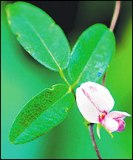 Small's
Milkpea (Galactia smallii)- Small's milkpea is endemic to the
pine rocklands of Miami-Dade County. This plant is a small,
trifoliolate, perennial legume with small, purple flowers and a
prostrate habit. Small's milkpea usually flowers during the summer,
however numerous flowers may bloom following a burn any time of the
year. Small's milkpea was listed as an endangered plant due to loss of
habitat in the
pine rocklands
caused by residential and commercial development. Small's
Milkpea (Galactia smallii)- Small's milkpea is endemic to the
pine rocklands of Miami-Dade County. This plant is a small,
trifoliolate, perennial legume with small, purple flowers and a
prostrate habit. Small's milkpea usually flowers during the summer,
however numerous flowers may bloom following a burn any time of the
year. Small's milkpea was listed as an endangered plant due to loss of
habitat in the
pine rocklands
caused by residential and commercial development.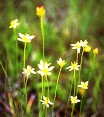 Harper's
Beauty (Harperocallis flava)- A perennial, yellow-flowered lily
found in the Florida panhandle, Harper's beauty has been over collected.
Also, its numbers have suffered from human and animal trampling,
off-road vehicle use, utility corridor and highway maintenance, and
encroachment by other vegetation. This lily's entire range is within
Apalachicola National Forest, mostly in areas under Forest Service
management but also on a few private lands. The species continues to
spread along a highway right-of-way passing through the Forest, possibly
as a result of mowing schedules that allow Harper's beauty seed
formation and dispersal while controlling the encroachment of competing
plants. Harper's
Beauty (Harperocallis flava)- A perennial, yellow-flowered lily
found in the Florida panhandle, Harper's beauty has been over collected.
Also, its numbers have suffered from human and animal trampling,
off-road vehicle use, utility corridor and highway maintenance, and
encroachment by other vegetation. This lily's entire range is within
Apalachicola National Forest, mostly in areas under Forest Service
management but also on a few private lands. The species continues to
spread along a highway right-of-way passing through the Forest, possibly
as a result of mowing schedules that allow Harper's beauty seed
formation and dispersal while controlling the encroachment of competing
plants. 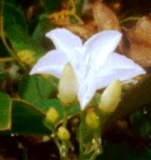 Beach
Jacquemontia (Jacquemontia reclinata)- Beach jacquemontia is
native and endemic to the increasingly rare and destroyed coastal
grassland, coastal dune, coastal beach and
coastal scrub habitats
along the southeastern coast of Florida, where it is found in only
Martin, Palm Beach, Broward, and Miami-Dade counties. Beach jacquemontia
is a member of the Morning Glory family and is a creeping vine with
attractive, white, small to medium star-shaped flowers which are
pollinated by insects. The leaves are small, slightly oval-shaped, and
pointed. As coastal development in southeastern Florida continues, this
plant's habitat continues to be destroyed and the plant itself is now
extremely rare and threatened. Beach jacquemontia does best in full
sun. Beach
Jacquemontia (Jacquemontia reclinata)- Beach jacquemontia is
native and endemic to the increasingly rare and destroyed coastal
grassland, coastal dune, coastal beach and
coastal scrub habitats
along the southeastern coast of Florida, where it is found in only
Martin, Palm Beach, Broward, and Miami-Dade counties. Beach jacquemontia
is a member of the Morning Glory family and is a creeping vine with
attractive, white, small to medium star-shaped flowers which are
pollinated by insects. The leaves are small, slightly oval-shaped, and
pointed. As coastal development in southeastern Florida continues, this
plant's habitat continues to be destroyed and the plant itself is now
extremely rare and threatened. Beach jacquemontia does best in full
sun.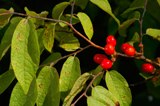 Pondberry
(Lindera melissifolia)- Pondberry, also called Southern spicebush, is a
medium-sized shrub that grows in swampy depressions in lowland forests.
Pondberry is a perennial, deciduous shrub that grows 1 1/2 to 6 1/2 feet
tall. It spreads byrunners that extend just below the surface and take
root to produce new plants. This shrub produces pale yellow flowers in
February or March before its leaves emerge. Pondberry leaves are long,
oval, untoothed and droop from the branches. The lower surface of each
leaf is slightly hairy. The leaves have a strong sassafras-like aroma
when crushed. Pondberry produces bright red elliptical fruits during
late summer; fruits mature during the fall. Pondberry
(Lindera melissifolia)- Pondberry, also called Southern spicebush, is a
medium-sized shrub that grows in swampy depressions in lowland forests.
Pondberry is a perennial, deciduous shrub that grows 1 1/2 to 6 1/2 feet
tall. It spreads byrunners that extend just below the surface and take
root to produce new plants. This shrub produces pale yellow flowers in
February or March before its leaves emerge. Pondberry leaves are long,
oval, untoothed and droop from the branches. The lower surface of each
leaf is slightly hairy. The leaves have a strong sassafras-like aroma
when crushed. Pondberry produces bright red elliptical fruits during
late summer; fruits mature during the fall.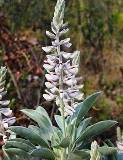 Scrub
Lupine ( Lupinus aridorum)- Scrub lupine is a woody perennial
herb, and is the only upright, pink-flowering lupine in Florida. On
stems that can reach three feet in height are long leaves that are
pointed at the top and rounded at the base. Both leaves and stems are
covered by thousands of tiny silver hairs. In bloom between March and
May, the flowers of Lupinus aridorum are a pale-pink color, and appear
in groups of 5 to 14 on flowering racemes. The fruit of this species is
found in June, and is long, woody, and elliptic in shape, tapering to a
sharp tip. Lupinus aridorum is endemic to Polk, Orange, and Oceola
Counties in central Florida where it occurs on the Mt. Dora Ridge in
Orange and on the Winter Haven Ridge in Polk County Scrub
Lupine ( Lupinus aridorum)- Scrub lupine is a woody perennial
herb, and is the only upright, pink-flowering lupine in Florida. On
stems that can reach three feet in height are long leaves that are
pointed at the top and rounded at the base. Both leaves and stems are
covered by thousands of tiny silver hairs. In bloom between March and
May, the flowers of Lupinus aridorum are a pale-pink color, and appear
in groups of 5 to 14 on flowering racemes. The fruit of this species is
found in June, and is long, woody, and elliptic in shape, tapering to a
sharp tip. Lupinus aridorum is endemic to Polk, Orange, and Oceola
Counties in central Florida where it occurs on the Mt. Dora Ridge in
Orange and on the Winter Haven Ridge in Polk County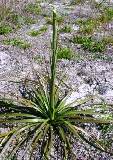 Britton's
Beargrass (Nolina brittoniana)- Brtitton's beargrass is a
perennial herb that is a member of the Agavaceae family. It has the
typical agave-like long, stiff leaves in a grass-like clump that rise
from a bulbous stem. The youngest leaves are erect while the older
leaves (up to 6 feet long, 0.5 inch wide) spread on the ground. The
flowering stalk reaches from 3 to 6 feet tall, and is topped with a
large, showy cluster of small while flowers. Britton's beargrass flowers
from March to May, but fruits, leaves, and growth habit are distinctive
all year. Male and female flowers are usually borne on separate plants.
Both plants are very conspicuous during flowering. The fruits are a
papery, symmetrical, 3-lobed capsule, persisting through the summer
Britton's beargrass occurs in Hernando, Highlands, Lake, Marion, Orange,
Osceola, and Polk counties of central Florida, in a wide range of
habitat types, from relatively
open scrub to hammocks
with closed canopies. All of the habitats where Britton's beargrass
occurs are considered upland sites where soil is droughty and infertile,
and are fire-dependent and fire-maintained ecosystems. Britton's
Beargrass (Nolina brittoniana)- Brtitton's beargrass is a
perennial herb that is a member of the Agavaceae family. It has the
typical agave-like long, stiff leaves in a grass-like clump that rise
from a bulbous stem. The youngest leaves are erect while the older
leaves (up to 6 feet long, 0.5 inch wide) spread on the ground. The
flowering stalk reaches from 3 to 6 feet tall, and is topped with a
large, showy cluster of small while flowers. Britton's beargrass flowers
from March to May, but fruits, leaves, and growth habit are distinctive
all year. Male and female flowers are usually borne on separate plants.
Both plants are very conspicuous during flowering. The fruits are a
papery, symmetrical, 3-lobed capsule, persisting through the summer
Britton's beargrass occurs in Hernando, Highlands, Lake, Marion, Orange,
Osceola, and Polk counties of central Florida, in a wide range of
habitat types, from relatively
open scrub to hammocks
with closed canopies. All of the habitats where Britton's beargrass
occurs are considered upland sites where soil is droughty and infertile,
and are fire-dependent and fire-maintained ecosystems.
|
|
|
Advertise | Privacy Statement | Dog Encyclopedia | Video |Contact | Alaska Nature |
|